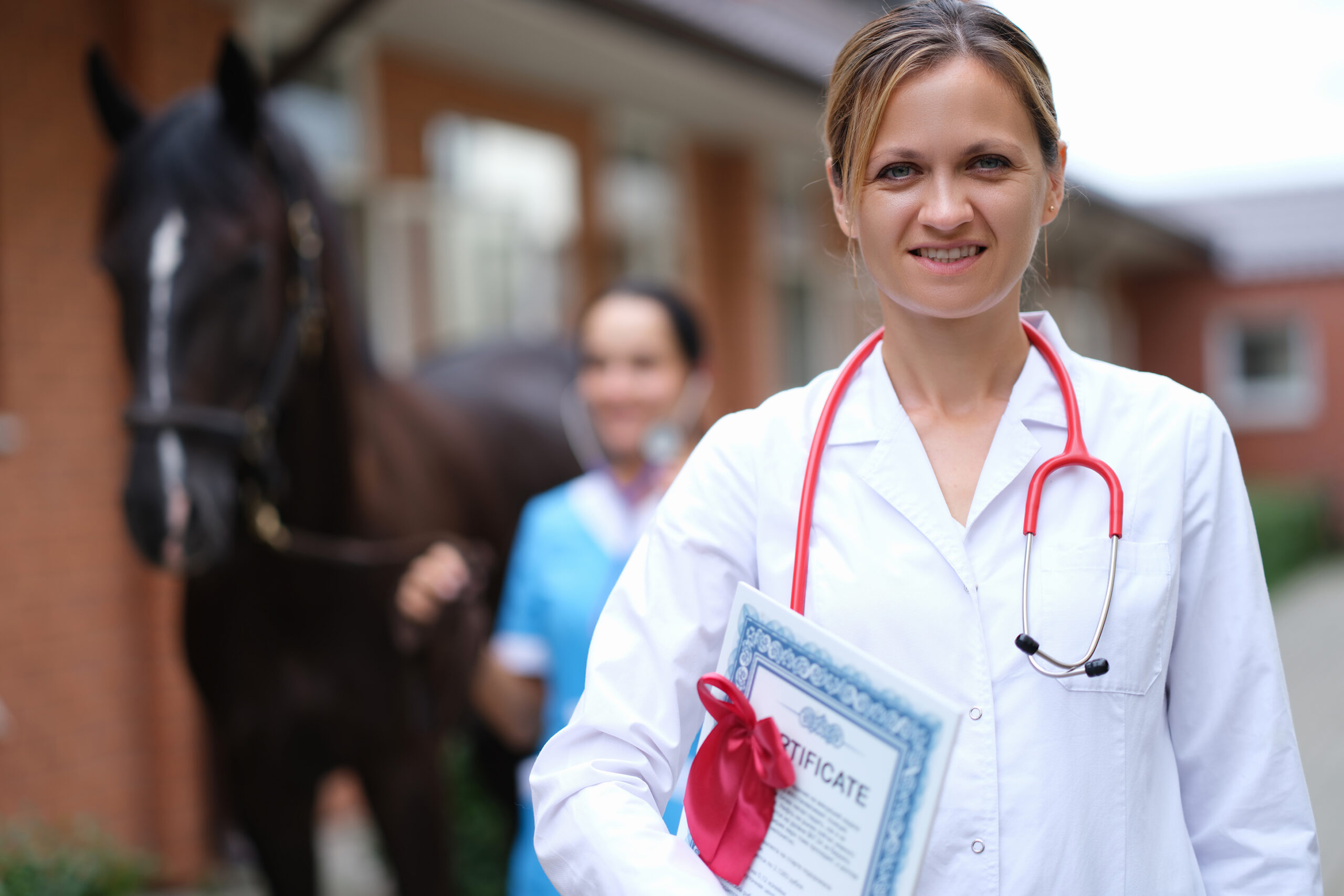
This year the British Veterinary Receptionist Association (BVRA) annual Veterinary Receptionist Survey received a higher response rate compared to 2021, with the survey being completed by 518 individuals. Almost two-thirds of respondents are currently employed full-time in the role of a veterinary receptionist, with the remaining 40 percent working part-time. Similar to last year’s survey, there was a roughly even split with 45 percent of respondents working in corporate practice and 55 percent working in independent practices across the UK.
The profile of the individuals in the receptionist role, according to those surveyed, was found to be consistent with general expectations and previous veterinary receptionist surveys. We found that 90 percent of receptionists are over 25 years old, and 85 percent were female. The respondents had generally been in their role for 1 to 10 years with 63 percent working in small animal practice, 14 percent in mixed practice and only 4 percent in referral practice.
Pay
One of the most interesting sections of our survey is about receptionists’ wages. Fifty-six percent of those surveyed were being paid more than the national living wage, which is an increase of 21 percent from 2021. However, 48 percent felt that they were not paid fairly for the job that they do. This shows that, compared to the 2021 survey, only 13 percent of receptionists have had an increase in wage satisfaction.
Our pay structure in no way represents our level of professionalism, responsibility, care and loyalty. We feel like ‘throw away’ members of the team
BVRA Receptionist Survey, 2022
In terms of working hours receptionists are most commonly contracted to work between 30 and 40 hours per week; however, 31 percent of participants stated that they regularly work longer than their contracted hours with an astounding 29 percent not receiving any overtime pay. One respondent attested: “We work long hours in a very stressful and often frenetic environment with no breaks in a six-hour shift. We are expected to work overtime without prior notice. We work weekends and Bank Holidays without any enhanced pay.”
CPD
Given the dynamic nature of the veterinary profession, CPD is an important aspect of any role. Half of those surveyed rated “keeping up to date and increasing their knowledge” as being an important factor in completing CPD, and a further 46 percent rated “benefit to the practice and clients” as also being important.
I absolutely love my job, but I would like to have more time to get some training done
BVRA Receptionist Survey, 2022
Further, 64 percent of those surveyed want to do more CPD to increase their knowledge and to benefit the practice and clients. That’s 64 in every 100 receptionists that want to do CPD to enhance their value, not for their own gain, but for the benefit of the practice. However, 52 percent of those who completed the survey said that their practice does not allocate any dedicated time for them to participate in CPD, and a further 35 percent of receptionists are not encouraged to complete CPD. Twenty-three percent said that lack of money was a barrier, as supported by one respondent who stated: “I would love to do more training, but my practice cannot afford for me to do so.”
Fifty-two percent of those who completed the survey said that their practice does not allocate any dedicated time for them to participate in CPD, and a further 35 percent of receptionists are not encouraged to complete CPD
Job satisfaction and team morale
Staff retention is a crucial element in running a successful veterinary practice, and within this, staff morale and job satisfaction is key to retaining good staff. Forty-one percent of respondents said they were either satisfied or very satisfied with overall morale in their practice. The average overall job satisfaction score was 4 out of 10 (zero being the lowest, 10 being the highest). This is up slightly from the previous two years which scored a mere 3 out of 10.
Job satisfaction remains low as receptionists report being overwhelmed due to staff shortages, increased workload and the rise in verbal abuse they receive. Of their experiences, one respondent said: “Morale in our practice has gone down. There is no let-up in staff shortages as many people have left the industry. The amount of verbal abuse has increased tenfold lately.”
A lack of communication can lead to others not being happy or satisfied
BVRA Receptionist Survey, 2022
Sixty-two percent of those surveyed reported receiving a good level of support from their line manager, but just over a third felt that the level of support could be better. Thirty-eight percent were satisfied with the level of recognition they received, which was up 6 percent from the 2021 survey. A further 39 percent reported being satisfied or very satisfied with the learning and development opportunities, but it seems there is room for improvement in the level of progression opportunities available to them with only 23 percent being satisfied with this aspect of their role.
Relationships within the practice team are another important aspect to overall morale. Of those surveyed, 68 percent reported being satisfied or very satisfied with their working relationship with both vets and nurses. Fifty-five percent reported being satisfied or very satisfied with the relationship with their practice manager, and 54 percent were satisfied or very satisfied with their relationship with their clinical directors/partners. Only 35 percent were satisfied with their relationship with their head office.
Job satisfaction remains low as receptionists report being overwhelmed due to staff shortages, increased workload and the rise in verbal abuse they receive
The survey revealed an increase in the number of receptionists who receive regular appraisals. Of the receptionists who responded to the 2022 survey, 62 percent receive regular appraisals representing an increase of 12 percent from 2021.
Five years on
The 2022 Receptionist Survey is the fifth annual survey BVRA has carried out. Over the last five years, there have been some interesting small changes in the veterinary receptionist’s role. When we started the survey, 98 percent of the receptionists surveyed were female. In 2022, 14 percent were male and 85 percent female with 1 percent preferring not to say. Although the average age group has remained the same at 25 to 34 years old, 60 percent of respondents work full-time, compared to 55 percent in 2018.
Pay
The average amount paid per hour in 2018 was between £8 and £9 per hour. In 2022, this has increased to £9 to £10 per hour. The percentage of those paid less than £10 per hour has dropped from 69 percent in 2018 to 41 percent in 2022. However, those satisfied or very satisfied with their level of pay has decreased from 37 percent in 2018 to just 31 percent in 2022. It is important to note that though these wage figures have increased, they stay in line with the mandatory national living wage.
The percentage of those paid less than £10 per hour has dropped from 69 percent in 2018 to 41 percent in 2022. However, those satisfied or very satisfied with their level of pay has decreased
CPD
In 2018 just 23 percent of those surveyed received paid CPD. This has nearly doubled to 40 percent in 2022; however, this represents a decrease from 2020 and 2021 when 56 percent said they received paid CPD. The percentage receiving a CPD allowance has increased from 45 percent in 2018 to 73 percent in 2022. Those citing a lack of time as a barrier to completing CPD is unchanged. Encouragingly, the percentage of respondents wanting to do more CPD has increased from 37 percent in 2018 to 65 percent in 2022, representing an increase of just under a third.
Job satisfaction and team morale
There has been a small rise in the level of support received, which has increased from 45 percent in 2018 to 49 percent in 2022. There has been another small gain in the level of recognition received which has increased by 6 percent from 2018. Progression opportunities have remained the same at 31 percent, dropping to just 21 percent in 2020 and 24 percent in 2021 most likely as a result of the COVID-19 pandemic.
Progression opportunities have remained the same at 31 percent, dropping to just 21 percent in 2020 and 24 percent in 2021 most likely as a result of the COVID-19 pandemic
Practice and team morale has decreased by 7 percent and 10 percent respectively, since 2018. Relationships with vets and nurses has increased since 2018 but is 10 percent lower than it was in 2020/21. There has been a slight increase in the relationship with the clinical director/partner, but a significant decrease in satisfaction in the relationship with the practice manager which has dropped from 68 percent in 2018 to 55 percent in 2022.
Final thoughts
The BVRA strives to raise the awareness and value of veterinary receptionists in the industry and in such a short time frame, there have been positive changes not only in the survey results but in the continual industry feedback. Since BVRA launched in 2017 there have been some small, positive shifts and changes in veterinary receptionists’ pay, CPD and job satisfaction:
It is hoped that the survey will help to continue to raise awareness of veterinary receptionists in the UK.
For further information about the BVRA and this year’s annual receptionist survey, please visit the BVRA website.












